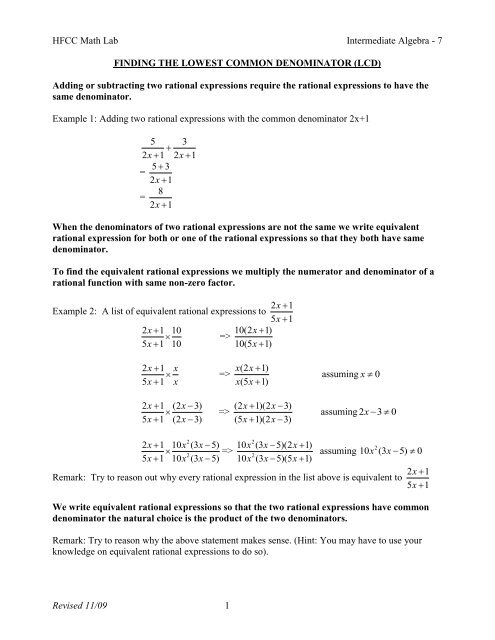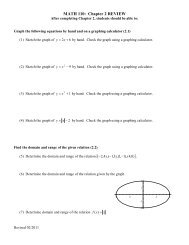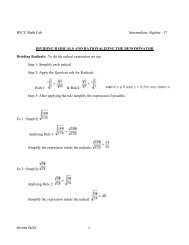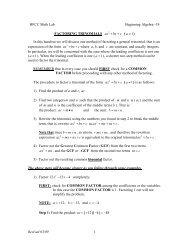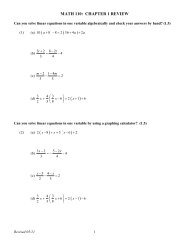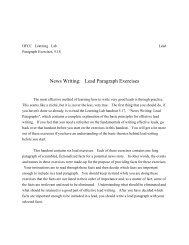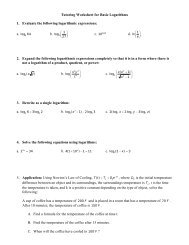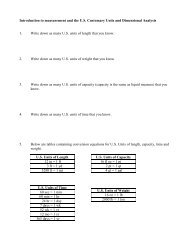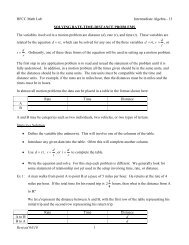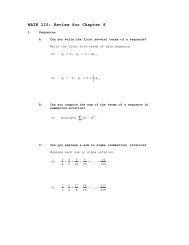Intermediate Algebra 07: Finding the Lowest Common Denominator
Intermediate Algebra 07: Finding the Lowest Common Denominator
Intermediate Algebra 07: Finding the Lowest Common Denominator
- No tags were found...
You also want an ePaper? Increase the reach of your titles
YUMPU automatically turns print PDFs into web optimized ePapers that Google loves.
HFCC Math Lab <strong>Intermediate</strong> <strong>Algebra</strong> - 7FINDING THE LOWEST COMMON DENOMINATOR (LCD)Adding or subtracting two rational expressions require <strong>the</strong> rational expressions to have <strong>the</strong>same denominator.Example 1: Adding two rational expressions with <strong>the</strong> common denominator 2x+15 32x1 2x1= 5 32x18=2x1When <strong>the</strong> denominators of two rational expressions are not <strong>the</strong> same we write equivalentrational expression for both or one of <strong>the</strong> rational expressions so that <strong>the</strong>y both have samedenominator.To find <strong>the</strong> equivalent rational expressions we multiply <strong>the</strong> numerator and denominator of arational function with same non-zero factor.Example 2: A list of equivalent rational expressions to 2 x 15x12x1 1010(2x1)=>5x1 1010(5x1)2x15x1xx=>x(2x1)x(5x1)assuming x 02x1 (2x3)5x1 (2x3)=>(2x1)(2 x 3)(5x 1)(2 x 3)assuming 2x3 022x 1 10 x (3x5)25x 1 10 x (3x5)210 x (3x 5)(2x1)210 (3 5)(5 1)=>x x x assuming 210 x (3x5) 0Remark: Try to reason out why every rational expression in <strong>the</strong> list above is equivalent to 2 x 15x1We write equivalent rational expressions so that <strong>the</strong> two rational expressions have commondenominator <strong>the</strong> natural choice is <strong>the</strong> product of <strong>the</strong> two denominators.Remark: Try to reason why <strong>the</strong> above statement makes sense. (Hint: You may have to use yourknowledge on equivalent rational expressions to do so).Revised 11/09 1
Example 3: Some of <strong>the</strong> multiples of <strong>the</strong> polynomial26 x(5x 1) are16 x(2x 1) 6 x(2x1)2 236 x(2x 1) 18 x(2x1)2 2x 6 x(2x 1) 6 x (2x1)5 2 6 25(2x 1) 6 x(2x 1) 30 x(2x1)2 37 x (2x 1) 6 x(2x 1) 42 x (2x1)2 3 2 3 5Remark: Try to reason out why every expression in <strong>the</strong> above list is a multiple of26 x(5x1)The best choice for <strong>the</strong> denominator is <strong>the</strong> Least <strong>Common</strong> Multiple (LCM) of <strong>the</strong>denominators of two expressions. We also refer to this value as <strong>the</strong> Least <strong>Common</strong><strong>Denominator</strong> (LCD)Remark: Try to reason why <strong>the</strong> above statement makes sense. (Hint: Least means smallest multipleof a polynomial. A smallest multiple of a polynomial has <strong>the</strong> least degree and yet can be written as aproduct of both <strong>the</strong> polynomials under consideration.)To find <strong>the</strong> least common denominator (LCD) of two or more fractional expression youcan follow this procedure:1. Factor each denominator completely, showing repeated factors as powers; i.e., asbases with exponents.2. Write <strong>the</strong> product of all <strong>the</strong> different bases without exponents.3. Raise each base to <strong>the</strong> highest exponent to which it is raised in any singledenominatorRemark: A base and its opposite (negative) can be considered <strong>the</strong> same when find <strong>the</strong>LCD; any (-1) factor can be attached to <strong>the</strong> numerator.Example 4: Simplifying rational expression with a -1 factor in <strong>the</strong> denominator1 1( x 2) x 2Example 5: Find <strong>the</strong> Least <strong>Common</strong> <strong>Denominator</strong> (LCD) of <strong>the</strong> expressionsSolution: Using <strong>the</strong> above procedure to find <strong>the</strong> LCDx 1 x 4 x, ,20 6 102022 56 23 10 25 23 5Step 1: Factor each denominator completely,showing repeated factors as powersStep 2: Write <strong>the</strong> product of all <strong>the</strong> differentbases without exponents.22 3 5 60Step 3: Raise each base to <strong>the</strong> highest exponentto which it is raised in any single denominatorRevised 11/09 2
1 5xy 7Example 6: Find <strong>the</strong> Least <strong>Common</strong> <strong>Denominator</strong> (LCD) of <strong>the</strong> expressions , ,2 2 318x y 10xy z 15yzSolution: Using <strong>the</strong> above procedure to find <strong>the</strong> LCD218x y210xy z215yz2 2 223 x y25x y35 yz3 zStep 1: Factor each denominator completely,showing repeated factors as powers23 5 x yzStep 2: Write <strong>the</strong> product of all <strong>the</strong> differentbases without exponents.2 3 5 902 2 3 2 3 x y z x y z Step 3: Raise each base to <strong>the</strong> highest exponentto which it is raised in any single denominator4 3 7Example 7: Find <strong>the</strong> Least <strong>Common</strong> <strong>Denominator</strong> (LCD) of <strong>the</strong> expressions , ,2 2a 1 2a 2 ( a 1)Solution: Using <strong>the</strong> above procedure to find <strong>the</strong> LCD2a a a1 ( 1) ( 1)2a2 2 ( a 1)2 2( a 1) ( a 1)Step 1: Factor each denominator completely,showing repeated factors as powers2 ( a 1) ( a 1)Step 2: Write <strong>the</strong> product of all <strong>the</strong> differentbases without exponents.22 ( a 1) ( a 1) Step 3: Raise each base to <strong>the</strong> highest exponentto which it is raised in any single denominator4 3 7Example 8: Find <strong>the</strong> LCD of <strong>the</strong> expressions , ,3 2 28x 27 x 6x 9 2x 3x9Solution: Using <strong>the</strong> above procedure to find <strong>the</strong> LCD3 28x 27 (2x 3) (4 x 6x9)x 6x 9 ( x 3)2 222x 3x 9 (2x 3) ( x 3)Step 1: Factor each denominator completely,showing repeated factors as powers2( x 3) (2x 3) (4x 6x9) Step 2: Write <strong>the</strong> product of all <strong>the</strong> differentbases without exponents.2 2( x 3) (2x 3) (4x 6x9) Step 3: Raise each base to <strong>the</strong> highest exponentto which it is raised in any single denominatorRevised 11/09 3
Example 9: Find <strong>the</strong> LCD of <strong>the</strong> expressions4 3,( x 2) (2 x)Solution: <strong>Denominator</strong>s are ( x 2) and its opposite are (2 x) 1( x 2) . Hence we move <strong>the</strong>4 3negative to <strong>the</strong> numerator ,( x 2) ( x 2)We do not have to use any procedure to find <strong>the</strong> common denominator because both <strong>the</strong> fractionshave <strong>the</strong> common denominator7 1Example 10: Find <strong>the</strong> LCD of <strong>the</strong> expressions ,26( x 5) 4(5 x)Solution: (5 x ) is <strong>the</strong> negative of ( x 5) hence rewriting <strong>the</strong> expressions we have7 1,26( x 5) 4( x 5)6( x 5) 23 ( x 5)2 224( x 5) 2 ( x 5)Step 1: Factor each denominator completely,showing repeated factors as powers2 3 ( x 5)Step 2: Write <strong>the</strong> product of all <strong>the</strong> differentbases without exponents.2 22 3 ( x 5)Step 3: Raise each base to <strong>the</strong> highest exponentto which it is raised in any single denominatorExercise: Find <strong>the</strong> Least <strong>Common</strong> <strong>Denominator</strong> (LCD) in each of <strong>the</strong> following exercise(Hint: follow <strong>the</strong> procedure suggested above)1.2 3,x xy2.3x2 x 4,8 123.1 3,x 2 6 3x4.3 5,4x 2y y 2x1 35. ,22xy x5 4 17. , ,2 38x 3xy 16y3 56. ,2 24a b 8b1 28. ,2 23n m nm9.9 4 3, ,a b a b10.3 8,5x20 9x36Revised 11/09 4
5 911. ,2 2c 2c 15 c 6c912.2y,2( y 3) 5( y 3)( y 1)y21 2 313. , ,26x 6 x 1 2x23x115. ,24 2x x 4y 3 5 7y17. , ,2 28y 16y 3y 21y 36 4y12x 4 x19. ,2 23x 11x 6 2x x 151 2 314. , ,2 2a 1 a 2a 1 2a21 116. ,2 2y 3y y 3y3 118. ,2 2x x 2 x 43 x 120. , ,3 210x 270 x 6x 9 6x18Solutions to <strong>the</strong> odd-numbered exercise and answers to <strong>the</strong> even- numbered exercise:1. <strong>Denominator</strong>s: x,xyStep1: x x,xy xyStep2:xyStep3:LCD xy2. LCD : 243. <strong>Denominator</strong>s x 2,6 3xStep1: x 2 ( x 2), 6 3x 3 ( x 2)Step2 : 3 ( x 2)Step3: LCD 3 ( x 2)Remark: opposite of (x-2) is (2-x)Hence we can rewrite <strong>the</strong> rational expression as1 3, and find <strong>the</strong> LCDx 2 3x64. LCD : 2( y 2 x ) or 2(2 x y )5. <strong>Denominator</strong>s 2 xy,xStep1: 2xy 2 x y,x xStep2 : 2x y2Step3: LCD 2x y7. <strong>Denominator</strong>s22 22 38 x ,3 xy,16yStep1:8x 2 x ,3xy 3 x y,16y 2 yStep2 : 23x y2 3 2 3 4 3Step3: LCD 2 3 x y 48x y4 2 3 2 36.8.LCD :8a b2 22 2LCD :3n mRevised 11/09 5
9. <strong>Denominator</strong>s a b, a,bStep1: a b ( a b), a a,b bStep2 : ab ( a b)Step3: LCD ab ( a b)11. <strong>Denominator</strong>s2 2c 2c 15, c 6c9Step1: c 2c 15 ( c 5)( c 3), c 6c 9 ( c 3)2 2 2Step2 : ( c 5)( c 3)Step3: LCD ( c 5)( c 3)213. <strong>Denominator</strong>s 6x 6, x 1,2 x 2Step1: 6x 6 23 ( x 1),x x x x x21 ( 1),2 2 2 ( 1) ( 1)Step2 : 23 ( x 1) ( x 1)Step3: LCD 23 ( x 1) ( x 1)15. <strong>Denominator</strong>s24 2 xx , 4Step x x y x x x21: 4 2 2 ( 2) , 4 ( 2)( 2)Step2 : 2 ( x 2) ( x 2)Step3: LCD 2 ( x 2) ( x 2)Remark: opposite of (x-2) is (2-x)Hence we can rewrite <strong>the</strong> fraction as3x1, and find <strong>the</strong> LCD22x4 x 417. <strong>Denominator</strong>sStep y y y y22 28y 16,3y 21y 36,4 y 122 31:8 16 2 ( 2),2 23y 21y 36 3 ( y 3) ( y 4),4y 12 2 ( y 3)Step2 : 2 y( y 2) ( y 3)Step3: LCD 2 y( y 2) ( y 3)19. <strong>Denominator</strong>s2 23x 11x 6,2x x 15Step x x x x21:3 11 6 (3 2)( 3),22x x 15 (2x 5)( x 3)Step2 : (3x 2) (2 x 5) ( x 3)Step3: LCD (3x 2) (2 x 5) ( x 3)10.12.14.2LCD : 3 5( x 4) or 45( x 4)2LCD : 5( y 3) ( y 1)2LCD : 2( a 1)( a 1)16. LCD : y( y 3)( y 3)18.20.2LCD : ( x 1)( x 2)2 2LCD : 30( x 3) ( x 3)( x 3x9)Revised 11/09 6
Note: You can get additional instructions and practice for solving <strong>the</strong>seproblems by going to <strong>the</strong> following websites:http://www.purplemath.com/modules/lcm_gcf.htm This website has step-by-stepinstruction on how to find <strong>the</strong> least common multiple of integers andpolynomials. <strong>Finding</strong> least common multiples is same as finding <strong>the</strong> leastcommon denominators.http://www.youtube.com/watch?v=drZopvFRa7s This website has a you tubevideo on how to find <strong>the</strong> least common multiple which is same as find <strong>the</strong> leastcommon denominator.http://www.wtamu.edu/academic/anns/mps/math/mathlab/col_algebra/col_alg_tut10_addrat.htm#lcd This website provides video demonstration and step-bystepinstruction on how to add two rational expressions. This website also hasinformation on how to find <strong>the</strong> least common multipleshttp://www.regentsprep.org/Regents/math/algtrig/ATO2/addfrac.htm Studentfriendly notes on adding and subtracting rational functions. This web site alsohas information on how to find <strong>the</strong> least common denominator of two or morefractionsRevised 11/09 7


